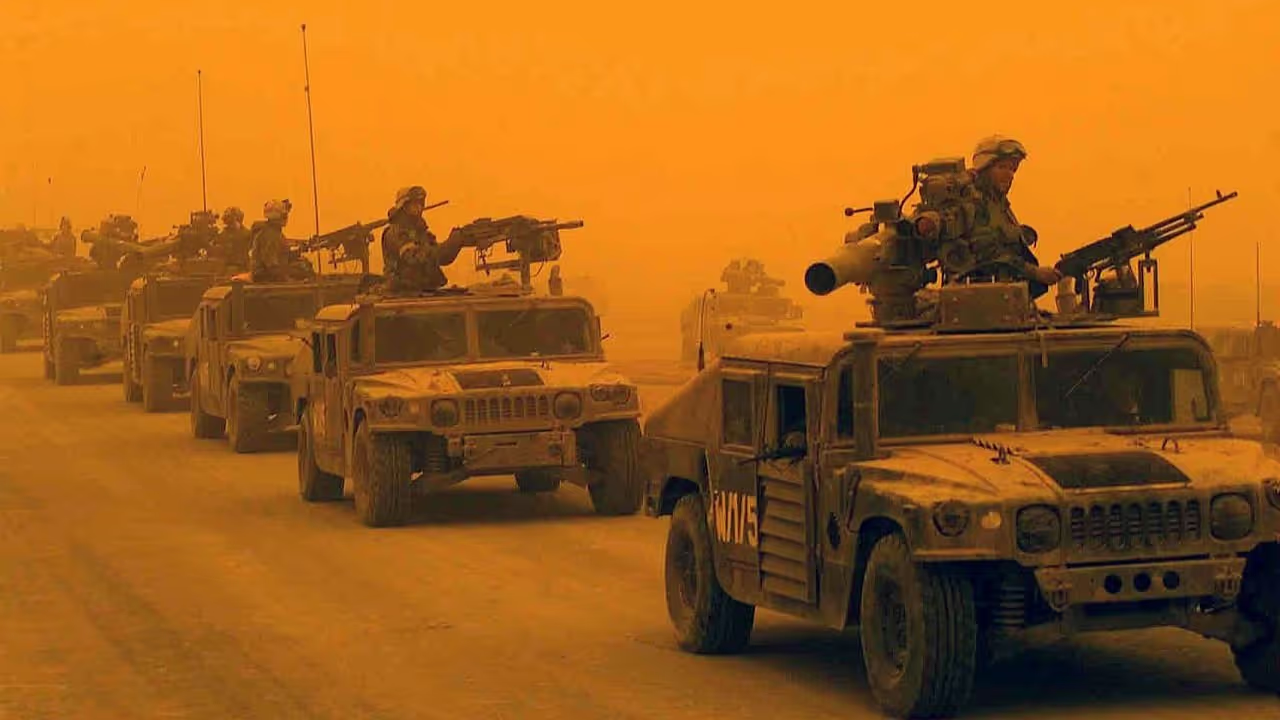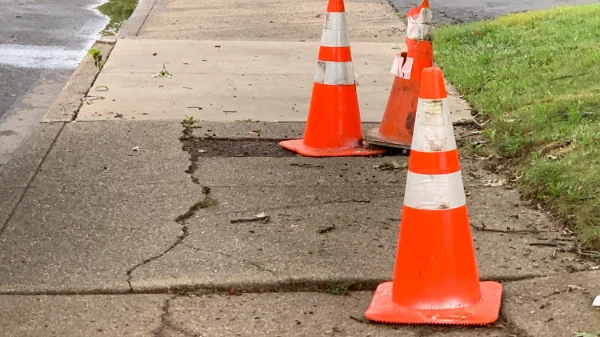Operation Iraqi Freedom—the U.S. invasion of Iraq that began on March 19, 2003—officially resulted in 3,481 hostile deaths to U.S. soldiers. There were obviously many more deaths, both of American soldiers, allied personnel, enemy soldiers, civilians, and others, that are attributed to the war, but allow me to make a point by focusing on the 3,481 U.S. combat deaths.
I remember a number of these fatalities. My National Guard unit, to which I was only a couple of years removed, was stationed in Kuwait and operating “in theater,” as they say. Every time there was a reported roadside bomb or other convoy strike that killed multiple troops at a time, it was an important event that drew our attention. It drew my attention.

And it drew the attention of public officials. Some in this audience will remember debates over armor on transport vehicles and the controversy of going to war with the military you have instead of the one you wish you had.
Upon completing a mission, soldiers perform what is known as an After Action Review, a chance to examine what worked, what went wrong, and how things can be improved. As happens in war, there was a lot more going wrong than most anticipated. The need for changes to address conditions on the ground became an urgent focus. I’m not analyzing the messy process by which these problems were addressed, but ultimately vehicles were equipped with extra armor and that protection is a standard feature now for transport vehicles in combat. (Note: My job in the military was truck driver, but I confess that my specific knowledge is a little dated at this point.)
I know these are sensitive topics, and it’s going to get more sensitive now. Please bear with me.
It is widely recognized that there is an epidemic of suicides among current and former military personnel, especially those who have been on active duty in a combat theater. There are a lot of theories as to why, but regardless of the cause, we can measure a significantly elevated rate of suicide attempts and deaths by suicide among soldiers than we measure in the general population. This is true even when those soldiers have not been under fire directly.
I am going to give you the number, but first I want to go back to the combat deaths. There were 3,481 combat deaths in Operation Iraqi Freedom. Since 9/11, there have been over 30,000 military suicides. Over 20 soldiers a day take their own lives. Many more attempt suicide. In my book, Strong Towns, I quote the journalist/author Sebastian Junger, who wrote a book partially on this topic called Tribe: On Homecoming and Belonging. Strong Towns readers will find it deeply insightful.
I’m treading in these sensitive waters because I want to make a point about the human condition and our response, one that will help us build better, safer, more prosperous places.
Soldier deaths by roadside bombs got our attention. Not only was the media trained on the war as it was unfolding, but often these incidents generated multiple casualties at the same time. In contrast, while we are all probably aware of the significantly larger problem of military suicides, the drip, drip, drip nature of them dulls the impact.
Perhaps even more importantly, there was something big we could do about combat casualties by roadside bombs; we could improve the armor on vehicles. That combination of large, highly-visible, negative events (mass death by roadside bomb), combined with a specific action step to be taken (provide more armor) meant that a top-down bureaucracy could ultimately address the problem. Now, it took too much time and was rather clumsy, but it did get addressed.
Suicides among veterans is not a large, highly visible event. It is the drip, drip, drip. Many of us know someone in the military who has died by suicide—I am aware of a couple—so the pain and the shock is real, but it’s not amplified in a way that prompts coordinated action.
In addition, there isn’t something easy to be done. Depression, anxiety, and suicide are complex mental challenges. There is no simple approach akin to spending more on armor that can be done to address them. There are a lot of people working heroically on these problems, but it remains a perplexing situation.
Part of why this problem has been so difficult to address is that it requires a messy, complex, bottom-up, and deeply personal response. Those are hard to do, especially if your underlying operating system—your fundamental DNA—is top down, which the military obviously is. The combination of drip, drip, drip and the lack of a single task to improve things means that the problem of military suicides is not one that is easily addressed by a top-down bureaucracy.
So much of our transportation bureaucracy is modeled on the military structure. Go to any state DOT and there will be hierarchies, silos, and interdepartmental rivalries just like those found in the military. The funding is also very top down, with transportation departments taking their cues from the leaders and bureaucracies pulling the funding levers upstream.
There is a good reason for this, and it’s important to understand. At the end of World War II, the United States embarked on a radical, progressive plan to reshape the continent, and the very way Americans lived, around a new set of understandings. Engineers were central to this mission. They were asked to, in a very short period of time, create an entirely new practice—highway engineering—and implement it, at scale, in every city, across a vast continent.
There was no way to accomplish this without military levels of precision, and so government bureaucracies, especially those involved in transportation, were molded into rigid silos with hierarchies, all ready to receive direction, standards, and funding from the top down.
When problems arose, those that mapped to the organizational DNA of transportation departments were addressed. Early on, this meant developing standards for signs, pavement types, and lane widths. After a couple of decades, process was layered on top of those in place in order to address environmental concerns. Even more process was added decades later to improve public engagement (I am using “improve” generously here). Safety advocates will also point to changes in seat belt laws, impaired driving enforcement, airbags, and other top-down mandates adopted over the years.
All of this is a lot like the armoring of transportation vehicles. Problems arise, they are identified and worked through, and ultimately there are top-down solutions implemented. I was reminded of this in an article about last week’s Amtrak derailment. The very headline explains all we need to know about where we are in the story of transportation safety: “NTSB team arrives in Missouri to investigate Amtrak derailment as death toll rises to 4.”
Four.
Now, I’m not going to suggest that four lost lives is not important—it absolutely is and we all feel a great deal of empathy toward these grieving families—but, on average, there will be more than four people killed every hour today on America’s roadways. Drip. Drip. Drip.
No NTSB team is going to mobilize to investigate those tragedies. Nobody is going to seek the underlying causes or ponder the multiple contributing factors. In fact, if we ask safety officials, as a group they officially blame driver error and reckless driving for fatal car crashes. In other words, don’t look at them.
There are two observations to make here relating the drip, drip, drip of auto deaths to veteran suicides. In both cases, the top-down bureaucracy is not equipped for the level of complexity, nuance, and personalization necessary to really get at the problem. For suicides, we’re talking about human-level interventions, something a large mission-driven organization like the military is just not oriented to do. For auto crashes, we’re talking about block level interventions, the kind of fine-grained design details that transportation departments are not able to perform.
In both situations, the only way we experience what we would think of as progress (a reduction in death and trauma) is by bottom-up leaders stepping into the void and providing the appropriate intervention. For cities, that means local technical and non-technical leaders recognizing that the current top down, military-style paradigm inherited from the highway-building era is inadequate, even counterproductive, to addressing the kinds of safety issues we have today. We need a new, bottom-up practice of traffic engineering that is focused on block-level safety interventions.
The second observation goes to the role of the old bureaucracy in making this transition. If we look at the military, they are taking steps, however slowly and however reluctantly, to address suicide. A huge step was to try and change the stigma around mental illness, to have an official policy of not punishing troops who struggle with mental health. The military has also started to work cooperatively with bottom-up organizations, not only supporting them but actually relying on them to fill in gaps where their top-down organization falls short. This is an ongoing process, but it feels like real progress is being made.
State departments of transportation, and transportation bureaucracies in general, need to do their part, as well. They need to recognize that the growing crash fatality rates are a direct challenge—even a rebuke—to their theory of traffic safety, which relies on applying highway buffering standards to local streets. They need to open up the design process, inviting more voices in—not just to comment, but to share insights into what the design needs to accomplish. And they need to stop attacking dissidents (i.e., those who challenge the status quo), and instead embrace the engineering mindset of problem solvers.
At Strong Towns, we are helping local leaders adopt new practices to improve traffic safety. Later this year, we are launching the Crash Analysis Studio, a recurring broadcast that will bring together both technical and non-technical experts to perform a full-cause analysis of a fatal or traumatic crash. In the Studio, we will demonstrate an approach to traffic safety that any city, and any set of local leaders, can adopt in their community.


.webp)
.webp)

